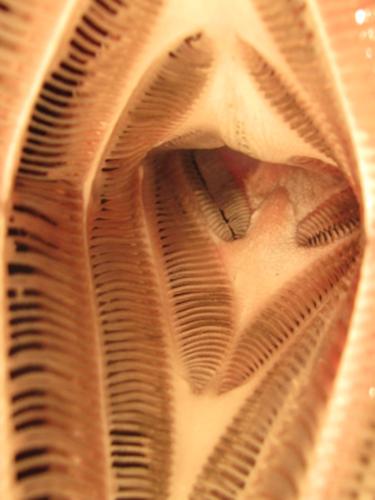当前位置:
X-MOL 学术
›
J. Exp. Zool. Part A
›
论文详情
Our official English website, www.x-mol.net, welcomes your
feedback! (Note: you will need to create a separate account there.)
Oropharyngeal morphology related to filtration mechanisms in suspension-feeding American shad (Clupeidae).
Journal of Experimental Zoology Part A ( IF 1.9 ) Pub Date : 2020-04-27 , DOI: 10.1002/jez.2363 Timothy James Storm 1, 2 , Katherine Ericson Nolan 1, 3 , Erin Michele Roberts 1, 4 , S Laurie Sanderson 1
Journal of Experimental Zoology Part A ( IF 1.9 ) Pub Date : 2020-04-27 , DOI: 10.1002/jez.2363 Timothy James Storm 1, 2 , Katherine Ericson Nolan 1, 3 , Erin Michele Roberts 1, 4 , S Laurie Sanderson 1
Affiliation

|
To assess potential filtration mechanisms, scanning electron microscopy was used in a comprehensive quantification and analysis of the morphology and surface ultrastructure for all five branchial arches in the ram suspension‐feeding fish, American shad (Alosa sapidissima, Clupeidae). The orientation of the branchial arches and the location of mucus cells on the gill rakers were more consistent with mechanisms of crossflow filtration and cross‐step filtration rather than conventional dead‐end sieving. The long, thin gill rakers could lead to a large area for the exit of water from the oropharyngeal cavity during suspension feeding (high fluid exit ratio). The substantial elongation of gill rakers along the dorsal‐ventral axis formed d‐type ribs with a groove aspect ratio of 0.5 and a Reynolds number of approximately 500, consistent with the potential operation of cross‐step filtration. Mucus cell abundance differed significantly along the length of the raker and the height of the raker. The mucus cell abundance data and the observed sloughing of denticles along the gill raker margins closest to the interior of the oropharyngeal cavity suggest that gill raker growth may occur primarily at the raker tips, the denticle bases, and the internal raker margins along the length of the raker. These findings will be applied in ongoing experiments with 3D‐printed physical models of fish oral cavities in flow tanks, and in future ecological studies on the diet and nutrition of suspension‐feeding fishes.
中文翻译:

悬浮饲料美洲American(Clupeidae)中与过滤机制有关的口咽形态。
为了评估潜在的过滤机制,使用扫描电子显微镜对定量饲喂公羊混悬鱼类美洲sha鱼(Alosa sapidissima,Clupeidae)中所有五个分支弓的形态和表面超微结构进行了全面的定量和分析。g耙上branch弓的方向和黏液细胞的位置与错流过滤和跨步过滤的机制更一致,而不是常规的死角筛分。长而细的g耙可能会在悬浮液喂食期间导致大面积的口水从口咽腔中流出(高出液率)。rak耙沿背腹轴的大量伸长形成d槽深宽比为0.5的雷诺型肋骨,雷诺数约为500,与跨步过滤的潜在操作一致。沿耙的长度和耙的高度,粘液细胞的丰度明显不同。黏液细胞丰度数据以及沿着closest口耙边缘最接近口咽腔内部的齿状体的脱落表明,ill口耙的生长可能主要发生在the口尖端,齿根基部和内ker边缘沿along骨的长度耙子。这些发现将被用于正在进行的使用3D打印的鱼缸中鱼口腔的物理模型进行的实验中,以及用于悬浮饲料鱼的饮食和营养的未来生态研究中。
更新日期:2020-04-27
中文翻译:

悬浮饲料美洲American(Clupeidae)中与过滤机制有关的口咽形态。
为了评估潜在的过滤机制,使用扫描电子显微镜对定量饲喂公羊混悬鱼类美洲sha鱼(Alosa sapidissima,Clupeidae)中所有五个分支弓的形态和表面超微结构进行了全面的定量和分析。g耙上branch弓的方向和黏液细胞的位置与错流过滤和跨步过滤的机制更一致,而不是常规的死角筛分。长而细的g耙可能会在悬浮液喂食期间导致大面积的口水从口咽腔中流出(高出液率)。rak耙沿背腹轴的大量伸长形成d槽深宽比为0.5的雷诺型肋骨,雷诺数约为500,与跨步过滤的潜在操作一致。沿耙的长度和耙的高度,粘液细胞的丰度明显不同。黏液细胞丰度数据以及沿着closest口耙边缘最接近口咽腔内部的齿状体的脱落表明,ill口耙的生长可能主要发生在the口尖端,齿根基部和内ker边缘沿along骨的长度耙子。这些发现将被用于正在进行的使用3D打印的鱼缸中鱼口腔的物理模型进行的实验中,以及用于悬浮饲料鱼的饮食和营养的未来生态研究中。











































 京公网安备 11010802027423号
京公网安备 11010802027423号